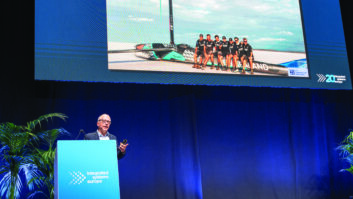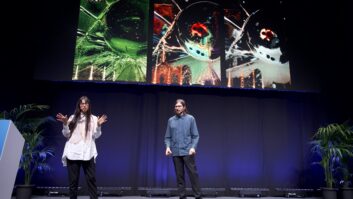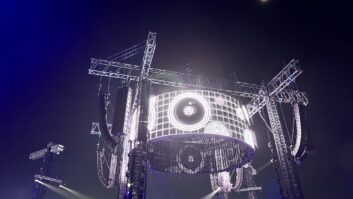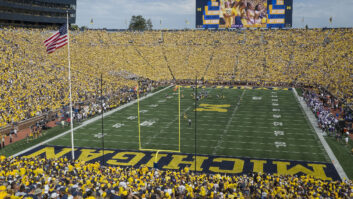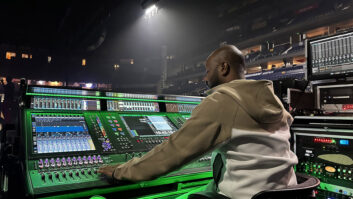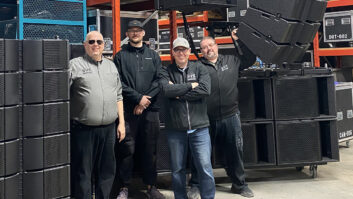Theatrical technology is as old as Ancient Greece – and perhaps even older. It was an early example of theatrical technology when, at an appropriate point in an ancient Greek drama, a god would very often (and very fortuitously, in many instances) appear, hoisted onto the stage by a crane. And that, of course, is where the phrase deus ex machina comes from.
Even today, audiences haven’t lost that appetite for the surprising and the spectacular – although the technology has moved a long way from actors wearing large masks to make themselves more visible as well as to amplify their voices for an audience that could be 15,000 or more.
And, judging by what the industry is saying, going to concerts and to the theatre is no less popular today than it was 2,500 years ago. “We’ve always been active in concert halls and theatres,” says Rob Lingfield of Martin Audio, “but we’ve seen our business grow disproportionately in the past five years. In fact, the past 12 months have been our most successful yet, with several very prestigious installations and a number of shows opening in London’s West End and around the world.”
Helen Meyer, executive vice president of Meyer Sound, is equally enthusiastic. “We’ve seen significant growth this past year in all of our traditional markets in Europe, within which the theatre/concert hall market plays a substantial role,” she says. “We offer a unique combination of comprehensive solutions and a strong commitment to customer support, and that’s proving to be a winning formula for us.”
It’s not just audio companies that are enjoying life at present. “It’s been hard for us to overcome the perception that we’re primarily a rock ’n’ roll company,” says Koy Neminathan, business development manager at lighting control company Avolites, “but our theatre business is unquestionably growing. The increasing use of moving lights in theatres is helping us. We’ve had success with our dimmers at Opera North, the English National Ballet and Scottish Opera, and that has helped us introduce our consoles into the theatre world.”
Tom Back is managing director of Alcons Audio. For him, the world is united by a common passion. “Alcons systems are being sold around the globe, from Korea to South Africa, and from Europe and Russia to the Americas,” he says. “Each area has its own specifics, but the funny thing is that, although we haven’t really focused on the theatre market specifically, in all areas it has become our main market, despite those regional differences. In some areas you have more municipally owned theatres, in other areas more privately owned. The deal may be done differently, but the bottom line is that engineers are curious about what Alcons sounds like. They hear it, and then want to work with it. Good sound breaks through language barriers.”
Lingfield sees a similar phenomenon. “As a global player, we are involved in many projects around the world,” he says, “and while the size, shape, acoustic properties and so on may vary, customers’ goals are very much the same – and therefore the route to achieving those goals is remarkably similar.”
Both Martin Audio and Alcons Audio see a key trend emerging in the market for audio solutions for concert halls and theatres – and that’s the growing acceptance of line arrays. Back notes in particular how line array technology is becoming increasingly available in smaller formats.
Line arrays are columns of closely and evenly spaced drivers that propagate sound in a cylindrical, rather than a spherical, manner. Not only does this way of configuring speakers allow better and more sound to reach a greater proportion of the audience, but line arrays are also easier to assemble and cable than, for example, distributed speakers.
Marco Hinic, chief executive officer of ArKaos, which provides technology for live visual performances, believes one of the biggest changes he has seen has been the acceptance of a software solution integrated within a hardware envi- ronment. “Our main product is a software product,” he says, “that will run on Windows or Mac, and we work extensively with partners to integrate with their hardware. Our partners include Avolites, Chamsys, Compulite and even companies with their own media servers, such as Martin or grandMA, or consoles such as High End Systems on its Road Hog consoles.”
Of course, attention to lighting and sound in theatres and concert halls is invariably focused on the performance area, but lighting and sound also have key roles to play in the public areas of auditoriums. Here, networking technology is becoming prevalent, as David Evans, data communications product manager at industrial computing company Amplicon, points out. “There is a real trend towards IP-based communication,” he says, “and the web is allowing remote control of a host of applications. Power over Ethernet is also becoming increasingly popular in next-generation lighting controllers, making the installation of a system much easier.” Amplicon’s ANE-208P Power over Ethernet switch is at the heart of a new lighting installation at London’s O2 Arena.
Back to the future
But if IP and PoE are hot technologies for Amplicon, what is the rest of the industry excited about? For Back, it’s the continuing development of a technology that first saw the light of day in 1928 – the ribbon transducer, which is claimed to have many advantages in loudspeaker performance. It doesn’t colour the sound; it is fast to respond, with instantaneous start and stop; and it has an extremely wide, flat frequency response.
“More and more brands are introducing ribbon-loaded systems,” says Back. “With up to 90% less distortion and a truly natural sound reproduction, it dramatically raises the bar in high-power sound reinforcement.
When people say there are no bad sound systems, what they’re really saying is that they’re all starting to sound the same. With current DSP developments camouflaging a lot of the negative aspects of compression driver technology, even low-quality systems can sound acceptable. This shrinks the quality bandwidth between good and bad sound systems. With our proribbon technology, we’ve substantially raised the bar in terms of the quality of sound that can be achieved.” It seems the difference is most noticeable at high sound pressure levels where, according to Back, proribbon technology makes high-fidelity sound at concerts possible – and lets an audience realise how much distortion they have historically taken for granted. He also notes how the tonal balance remains the same at low, medium or high SPLs. He goes on to talk about the Alcons Audio Q-series pro-ribbon line source columns. A modular system with extreme vertical projection control – it is designed for use in highly reverberant venues – the Qseries is said to feature very high intelligibility without beamsteering, but with full-frequency bandwidth and up to 150dB dynamic peak output.
“The market is not yet accustomed to that form factor,” says Back, “but when they’ve used it once, they discover how versatile the product actually is.” Customers that have reacted positively include Red Bull’s Hangar-7 in Austria, Gläserne Manufaktur von Volkswagen, the Fraunhofer Institute in Germany and the Pathé Cinema Group.
Positive response
Over at Martin Audio, Lingfield is just as excited about his company’s W8LC and W8LM medium- and small-format line array cabinets. “The acceptance of these in the theatre and concert hall marketplace has been very gratifying,” he says. Scaled-down versions of the W8Longbow ‘parent’ line array, the W8LC is a compact three-way enclosure, while the W8LM is characterised as a mini enclosure and is designed for small and medium-sized applications. All of these can be f lown or groundstacked, as required.
Still on the subject of sound, Helen Meyer believes that Meyer Sound’s Constellation system can revolutionise the way in which performance spaces can be used. “It is typically true that a venue is designed for a specific type of performance,” she says, “and the acoustic characteristics of the venue reflect that. For example, theatres are designed for voice, while concert halls are designed for music.
“But suppose a theatre wanted to put on musical productions – or a concert hall wanted to feature a play? That’s where the Constellation system can be used to create a multipurpose performance space. It enables any venue to have a wide variety of acoustic settings, which means it can then be used for many different types of performances.” The Constellation system also provides a flexible electronic orchestra shell that improves the experience of the performers and enhances the intelligibility of spoken-word presentations.
As IE reported earlier this year (March, page 6), Meyer Sound’s first European installation of a Constellation system was in the auditorium at Laboral University in Gijón, Spain. Grammy award-winning classical recording engineer John Pellowe, part of the Meyer Sound design team for the project, recounted a convincing demonstration that occurred when he turned the system off during a break in rehearsals. The musicians were shocked by the difference in the acoustic. “They were not even aware they were playing in an enhanced environment until I turned it off,” he recalled.
Meyer Sound is one of the longest-established companies in the theatre technology business – but a relative newcomer is Interspace Industries. Although the company has been providing cueing, presenter timing and other technical solutions for corporate live events for over 20 years, the TheatreCue represents its first foray into the world of drama and music.
“We talked to people in the stage business to find out what they really wanted, and we saw an opportunity for a solution that was more reliable and more cost-effective for event cueing,” says Dave Humphrys, managing director of Interspace Industries. “The TheatreCue uses LEDs rather than filament lamps at both the main control rack and the outstations, for example, consuming less power and lasting longer. The system has built-in diagnostics, so that the user is always assured that everything is working – rather than finding out after the event that something has failed. Cabling outstations using the TheatreCue is also much more efficient, saving both time and money.”
Lighting the way
In lighting, there are also changes afoot – but the pace of change is not rapid. “Traditional lighting instruments will continue to be mainstream for the foreseeable future,” notes Neminathan, “not least because LED-based equivalents continue to be very expensive. On the other hand, we’re seeing more moving lights – and media servers – in theatres, and that trend is allowing us to enter a market that wasn’t previously available to us. We’ve also developed our theatre stack functions, which are proving interesting to lighting designers who have never used our consoles before.”
However, as multimedia becomes an increasingly important element of both stage productions and concerts, LED technology is certainly finding a place. Hinic points to the rise in popularity of LED lighting to show video. “LED lighting is hot for us,” he says. “Our LED Mapper extension allows the implementation of very complex mapping, but the ArKaos VJ DMX software remains very simple, allowing the user to trigger and mix video loops.” He sees an opportunity in the rising number of small venues – a trend spotted by Humphrys as well – that are often more experimental in nature and prepared to do something different from the mainstream. Any solution for this market must, says Hinic, be both easy to use and scalable. “To be attractive to more users in smaller venues, we need to have simple solutions that allow more integration,” he explains. “For example, we see two divergent trends – LEDs running at low resolutions on the one hand, and the move towards high-definition video on the other. We need to allow our users to do both, and to do so easily.” He continues: “And then we need to realise that the needs of those users will evolve. We’ve seen many users migrate from having a single computer running ArKaos VJ DMX to a system that controls LEDs, plasma screens and traditional lighting – all integrated from a single control point. The need to do that will certainly continue as different types of media become more accessible.” ArKaos may not yet be mainstream theatre technology – but Neminathan sees it as being part of the digital revolution that is gathering pace.
“More advanced theatrical shows are now using digital equipment, such as media servers and digital projectors, as an integral part of the show,” he says. “Shows such as those of Cirque du Soleil use an ever increasing number of media servers that project any movie or image file – not just a colour or gobo. I believe theatres will follow this trend in years to come: the barrier at present is the cost, but once that comes down then we will see more digital lighting.
“We ensure that the user or lighting designer can control any type of generic, moving light, digital light or media server.” For the most part, it seems that audiovisual technology in established theatres and concert halls is in a state of evolution rather than revolution. Improvements are real but incremental – not least because the underlying technologies are, typically, relatively mature, and the customer base is inherently conservative in outlook.
The market is, however, showing good growth – driven on the one hand by the need to ‘put on a show’, and on the other by lighting and audio solutions that are becoming more capable, more flexible, more reliable and more affordable. As that trend continues, it seems likely that more adventurous smaller venues will proliferate – and, for those companies with the right products and services at the right prices, will become an attractive and potentially profitable market in their own right.
